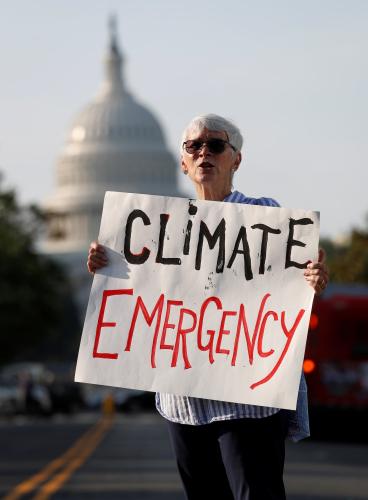There are two principles for reducing greenhouse gas (GHG) emissions efficiently. First, abatement should occur up to the point where the costs of going any further would outweigh the extra benefits. Second, a common price signal across countries and sectors ensures the most cost-effective reductions.
On efficiency grounds, a global price of carbon is unexceptionable. The benefits and costs of action should be thought of in terms of the expected impacts on wellbeing over time, appropriately discounted. At a simple level, the price of carbon is determined at the point where the downward sloping marginal benefit from emission reduction (“demand”) curve intersects the (upward sloping) marginal cost of reducing emissions curve (the familiar scissors of economics 101!). The price signal (tax) should trend upwards over time as the social cost of carbon is likely to increase as concentrations rise towards the long-term stabilisation goal (it is not an easy tax to implement).
Although science informs us that the ‘social cost’ of emitting a tonne of GHGs is independent of where in the world it is emitted, there are obviously significant differences in marginal abatement cots across locations due to differences in rates of output and emissions growth, as well as differences in the structure of economies and energy sectors. If the carbon price across countries is not broadly similar, there will be unexploited opportunities to abate an extra tonne of GHG more cheaply in one country compared with another. Current estimates of the social cost of carbon are much higher than the marginal abatement cost today. The academic literature provides a range of estimates of the social cost of carbon, from $0/tonne to over $400/tonne. The mean value of estimates in recent surveys has values around $30/tonne, and there are studies with a lower figure.
Broad agreement on a common global emissions target will necessitate requisite and predictable subsidies to developing countries (for on-the-ground diffusion of carbon emission abatement technology). Advances in technology will have to be viewed as global public goods; furthermore, the intellectual property right regime may have to be relaxed as part of a multi-pronged strategy (as in the case of anti-AIDS drugs). The incremental costs of low-carbon investments in developing countries will be substantial, estimated in the range of $20-30 billion/year. Supporting reduction in costs of low GHG emitting technologies (such as fuel cells, for example) is critical and estimates suggest that the Global Environment Facility (GEF) would require a ten-fold increase in funding to accomplish this (since inception in 1991, the GEF has provided $6.2 billion in grants).
It may prove difficult to use taxes to evolve a common price signal in the absence of political commitment to move towards a harmonised carbon tax across countries. A common price signal can also be delivered through tradable quotas. To the extent that a tradable quota scheme embraces different countries and sectors, it may be an effective way of delivering a consistent price signal, though this requires agreement on the mechanics of the scheme, not least appropriate initial distribution of quotas. Equally important are monitoring, reporting and verification (MRV) rules to ensure that a tonne of carbon emitted or reduced in one factory is equal to a tonne of carbon emitted or reduced in another factory.
Emissions’ trading is not new to environmental policy, for example, trading in emissions has been used successfully since 1995 (under the US Acid Programme) to reduce sulphur dioxide and nitrous oxide emissions that cause acid rain. The biggest plans for new emissions trading market are in the US through the Regional Greenhouse Gas Initiative from 2009, and California’s plans for using a cap-and-trade scheme from 2008 to reduce emissions by 25 percent by 2020. The voluntary market for carbon reductions is also growing (Chicago Climate Exchange is an example).
The Kyoto Protocol (KP) binds participating developed countries to legally binding commitments to reduce their overall emissions of a basket of six GHGs by at least 5 per cent below 1990 levels over the first commitment period 2008-2012. In effect, an overall national quantity ceiling or quota has emerged for each signatory. The KP, very importantly, but less heralded, has established the institutional basis for monitoring, reporting and verifying emissions to build up a registry of ‘emissions inventory”; it is too early to assess with confidence the accuracy and effectiveness of the system on this dimension (accurately measuring emissions is neither inexpensive nor easy).
The EU’s Emissions Trading Scheme (ETS) launched in January 2005 is the first international emissions trading scheme covering about 40 percent of EU emissions, with the permit market over the three-year period worth around $115 billion (2 billion allowances/year with the average allowance price of $19). The EU states decide through their National Allocation Plans (NAPs) the allotment of emissions allowances within their country. In the ETS, allocation decisions were based on projections of business-as-usual (BAU) emissions that were overestimated, with the result that it was hardly effective for curbing emissions; the total EU allocation turned out to be just 1 percent below the BAU scenario! In contrast, earlier successful emissions trading schemes such as the US Sulphur Dioxide trading programme, had allocation levels at around 50 percent below baseline emissions. In mature economies where the composition of sectors/industry is relatively stable, allocations are easier to make than in (developing) countries where the industry structure is more dynamic and less settled; there is a distinct possibility that allocations can turn out to be entry barriers (license-permit raj) for new firms.
Apart from naming and shaming non-compliant parties, the KP suffers from the usual and challenging time inconsistency problems of legally binding rules that have little by way of tangible sticks and carrots to elicit behaviour congruent to the objectives underpinning the initiative. However, while enforceability at the international level may be impossible, national governments can enforce tougher standards in the manner analogous to that is deployed for ubiquitous and long-standing pollution benchmarks that are in place in practically all countries.



Commentary
Op-edThe Challenges of Emissions Trading
November 16, 2007